中国历史文化概况(英文版)Unit 10 Chinese Cuisine, Tea and Medicine
中国历史文化英文介绍
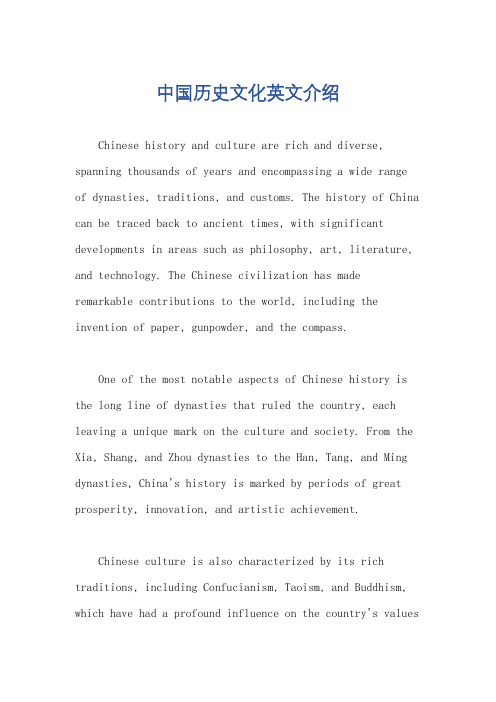
中国历史文化英文介绍Chinese history and culture are rich and diverse, spanning thousands of years and encompassing a wide range of dynasties, traditions, and customs. The history of China can be traced back to ancient times, with significant developments in areas such as philosophy, art, literature, and technology. The Chinese civilization has made remarkable contributions to the world, including the invention of paper, gunpowder, and the compass.One of the most notable aspects of Chinese history is the long line of dynasties that ruled the country, each leaving a unique mark on the culture and society. From the Xia, Shang, and Zhou dynasties to the Han, Tang, and Ming dynasties, China's history is marked by periods of great prosperity, innovation, and artistic achievement.Chinese culture is also characterized by its rich traditions, including Confucianism, Taoism, and Buddhism, which have had a profound influence on the country's valuesand social structure. Traditional Chinese art, such as calligraphy, painting, and poetry, reflects the beauty and elegance of Chinese aesthetics. Additionally, Chinese cuisine, with its diverse flavors and regional specialties, is renowned around the world.The Great Wall, the Forbidden City, the Terracotta Army, and the Silk Road are just a few examples of China'scultural and historical landmarks that continue tocaptivate people from all over the globe. Overall, Chinese history and culture are a testament to the enduring legacyof one of the world's oldest civilizations.。
中国文化介绍英文版Chinese Culture introduction
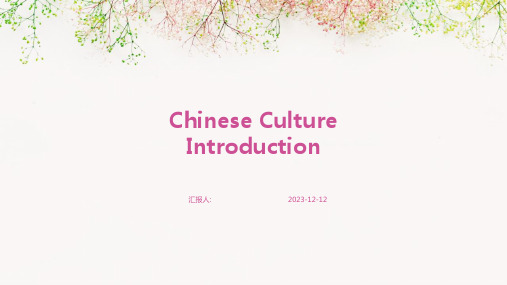
The commonly used techniques and styles in Chinese painting include ink painting, meticulous painting, freehand brushwork, etc., each with its unique aesthetic value and artistic expression.
Chinese Ceramics and Chinese Knives
Chinese porcelain is most famous for porcelain from Jingdezhen, Longquan Kiln, and other places, with a history dating back to the Tang Dynasty.
03
Buddhism and Zen Buddhism have a deep impact on Chinese culture, including Chinese poetry, calligraphy, painting, music, and folk customs They also spread to other countries and regions in the world
The Origin of Chinese Culture
The origin of Chinese culture can be traced back to the Yellow River basin, which is considered the slogan of Chinese civilization The Yellow River is an important river in China that has nurtured the growth of many urban civilizations
一年级用英语介绍中国文化作文

一年级用英语介绍中国文化作文示例回答如下1:Title: Introducing Chinese Culture to First GradersIntroduction:China, a country rich in history and diverse traditions, has a unique and fascinating culture that spans thousands of years. In this essay, we will explore some key aspects of Chinese culture that can be introduced to first-graders in an engaging and accessible way.Body:1. Chinese Language:Chinese is one of the oldest and most widely spoken languages in the world. With its unique characters, learning Chinese can be an exciting adventure for first-graders. They can start by learning simple words and phrases, such as greetings like "ni hao" (hello) and "xie xie" (thank you). Additionally, introducing them to the beauty of Chinese calligraphy can spark their interest in writing.中文:标题:向一年级生介绍中国文化介绍:中国是一个历史悠久、传统多样的国家,拥有独特而迷人的文化,跨越了数千年。
有关中国历史文化的讲座英文作文

有关中国历史文化的讲座英文作文The ancient civilization of China is a tapestry woven with threads of rich history and profound culture. Its tapestry stretches back over five millennia, showcasing the ingenuity of its people and the enduring legacy of its dynasties.From the majestic Great Wall to the serene beauty of the Forbidden City, China's historical landmarks stand as silent witnesses to the country's tumultuous past and its artistic achievements. These monuments are not just structures but narratives of a civilization that has thrived through the ages.The lecture delves into the philosophical underpinnings of Chinese culture, exploring the teachings of Confucius that have shaped social norms and governance for centuries. It also touches upon the influence of Daoism and its emphasis on harmony with nature, a philosophy that has permeated Chinese art and literature.The art of calligraphy and the delicate strokes of ink on rice paper reveal the elegance of Chinese script, a language that is as much visual as it is linguistic. Each character is a story, a window into the soul of the culture.The lecture also traverses the culinary landscape of China, a cuisine that is as diverse as its geography,reflecting regional tastes and the country's agricultural bounty. From the fiery kick of Sichuan peppercorns to the succulent flavors of Peking duck, Chinese cuisine is a testament to the nation's culinary creativity.In the realm of folklore and mythology, the lecture uncovers the stories that have been passed down through generations, tales of heroes and dragons, of love and loss, that continue to inspire and captivate the imagination.Finally, the lecture concludes with a look at the modern face of China, a nation that is both rooted in its traditions and rapidly evolving. It is a country where the past and the future coexist, a testament to the resilience andadaptability of its people.Through this lecture, we aim to provide a glimpse into the rich tapestry of Chinese history and culture, inviting participants to appreciate the depth and diversity of a civilization that has contributed immensely to the world's cultural heritage.。
中国的历史文化英文作文

中国的历史文化英文作文下载温馨提示:该文档是我店铺精心编制而成,希望大家下载以后,能够帮助大家解决实际的问题。
文档下载后可定制随意修改,请根据实际需要进行相应的调整和使用,谢谢!并且,本店铺为大家提供各种各样类型的实用资料,如教育随笔、日记赏析、句子摘抄、古诗大全、经典美文、话题作文、工作总结、词语解析、文案摘录、其他资料等等,如想了解不同资料格式和写法,敬请关注!Download tips: This document is carefully compiled by theeditor. I hope that after you download them,they can help yousolve practical problems. The document can be customized andmodified after downloading,please adjust and use it according toactual needs, thank you!In addition, our shop provides you with various types ofpractical materials,such as educational essays, diaryappreciation,sentence excerpts,ancient poems,classic articles,topic composition,work summary,word parsing,copyexcerpts,other materials and so on,want to know different data formats andwriting methods,please pay attention!China has a rich history and culture that spans thousands of years. From ancient dynasties to modern-day developments, China has always been a land of diversity and innovation.In ancient times, China was ruled by powerful dynasties such as the Han, Tang, and Ming. These dynasties leftbehind a legacy of great achievements in art, literature, and architecture. The Great Wall of China, for example, isa testament to the engineering skills of the ancient Chinese. It is a symbol of their determination and strength.Chinese culture is deeply rooted in Confucianism, which emphasizes respect for elders, filial piety, and thepursuit of knowledge. These values have shaped the Chinese society for centuries and are still influential today. Chinese people also have a strong sense of community and family, which can be seen in the importance placed onfamily gatherings and celebrations.Chinese cuisine is renowned worldwide for its variety and flavors. From spicy Sichuan dishes to delicate Cantonese dim sum, Chinese food offers a culinary adventure for the taste buds. Traditional Chinese medicine, with its focus on herbal remedies and balance, is another unique aspect of Chinese culture that has gained popularity globally.The art of calligraphy and painting has a long historyin China. Chinese calligraphy is not just a form of writing, but also a way of expressing emotions and aesthetics. Chinese paintings, often depicting landscapes or scenesfrom daily life, are known for their delicate brushwork and attention to detail.China's rapid economic growth in recent decades has brought about significant changes in its culture. The younger generation is more exposed to Western influences through technology and media. However, traditional values and customs still hold a special place in the hearts of many Chinese people.China's long history and diverse culture make it a fascinating country to explore. Whether it's visiting historical sites, sampling local cuisine, or immersing oneself in traditional customs, there is always something new to discover in this ancient land. So next time you find yourself in China, be prepared to be amazed by its rich history and vibrant culture.。
中国的历史和文化英语作文

中国的历史和文化英语作文China has a long and rich history, full of dynasties, emperors, and ancient traditions. The Great Wall, builtover 2,000 years ago, is a symbol of China's strength and determination. 。
Chinese culture is diverse and colorful, withtraditional arts such as calligraphy, painting, and opera. The Chinese New Year, also known as the Spring Festival, is a time of celebration and family reunions. 。
Confucianism, Taoism, and Buddhism are three major philosophies that have shaped Chinese society for centuries. The teachings of Confucius emphasize the importance of family, respect, and harmony. 。
Chinese cuisine is famous around the world for its variety and flavors. From spicy Sichuan dishes to delicate Cantonese dim sum, there is something for everyone to enjoy. 。
The Forbidden City, located in Beijing, was theimperial palace of the Ming and Qing dynasties. Itsintricate architecture and beautiful gardens are a testament to China's imperial past. 。
中国文化概况廖华英中英对照版
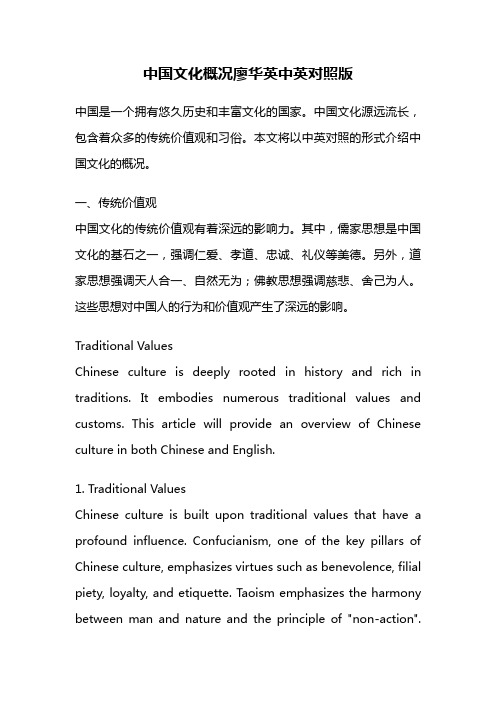
中国文化概况廖华英中英对照版中国是一个拥有悠久历史和丰富文化的国家。
中国文化源远流长,包含着众多的传统价值观和习俗。
本文将以中英对照的形式介绍中国文化的概况。
一、传统价值观中国文化的传统价值观有着深远的影响力。
其中,儒家思想是中国文化的基石之一,强调仁爱、孝道、忠诚、礼仪等美德。
另外,道家思想强调天人合一、自然无为;佛教思想强调慈悲、舍己为人。
这些思想对中国人的行为和价值观产生了深远的影响。
Traditional ValuesChinese culture is deeply rooted in history and rich in traditions. It embodies numerous traditional values and customs. This article will provide an overview of Chinese culture in both Chinese and English.1. Traditional ValuesChinese culture is built upon traditional values that have a profound influence. Confucianism, one of the key pillars of Chinese culture, emphasizes virtues such as benevolence, filial piety, loyalty, and etiquette. Taoism emphasizes the harmony between man and nature and the principle of "non-action".Buddhism emphasizes compassion and self-sacrifice. These philosophies have greatly shaped the behavior and values of the Chinese people.二、艺术与文学中国文化以其丰富多样的艺术形式而闻名。
中国的历史与文化英语作文
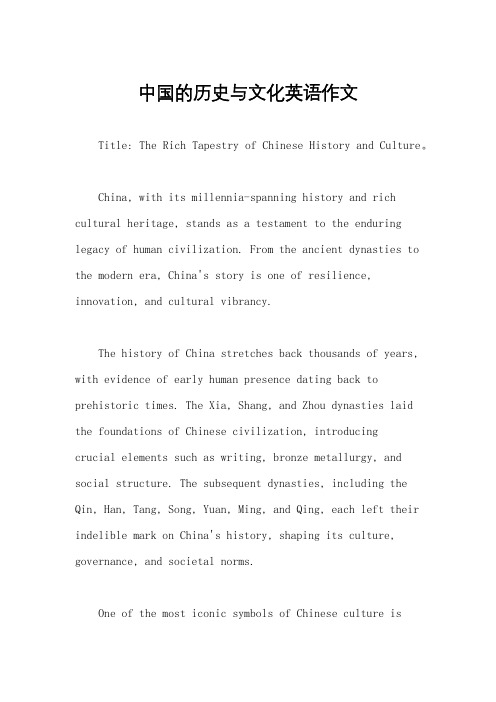
中国的历史与文化英语作文Title: The Rich Tapestry of Chinese History and Culture。
China, with its millennia-spanning history and rich cultural heritage, stands as a testament to the enduring legacy of human civilization. From the ancient dynasties to the modern era, China's story is one of resilience, innovation, and cultural vibrancy.The history of China stretches back thousands of years, with evidence of early human presence dating back to prehistoric times. The Xia, Shang, and Zhou dynasties laid the foundations of Chinese civilization, introducingcrucial elements such as writing, bronze metallurgy, and social structure. The subsequent dynasties, including the Qin, Han, Tang, Song, Yuan, Ming, and Qing, each left their indelible mark on China's history, shaping its culture, governance, and societal norms.One of the most iconic symbols of Chinese culture isthe Great Wall, a monumental feat of engineering constructed over centuries to defend against invasions from northern nomadic tribes. Spanning thousands of miles, the Great Wall stands as a testament to the ingenuity and determination of the ancient Chinese people.Confucianism, Taoism, and Buddhism are among the philosophical and religious traditions that have profoundly influenced Chinese society. Confucianism, with its emphasis on ethics, morality, and social harmony, has shaped Chinese governance and interpersonal relationships for centuries. Taoism, with its focus on living in harmony with thenatural world, has inspired art, literature, and spiritual practices. Buddhism, introduced to China from India, has merged with indigenous beliefs to form a unique Chinese Buddhist tradition, influencing art, architecture, and societal values.The arts have always held a central place in Chinese culture, encompassing a wide range of disciplines such as calligraphy, painting, poetry, music, and literature. Chinese calligraphy, characterized by its gracefulbrushstrokes and intricate characters, is considered both a form of artistic expression and a spiritual practice. Traditional Chinese painting often depicts landscapes, nature, and scenes from everyday life, evoking a sense of harmony and tranquility. Poetry, with its lyrical beauty and profound insights, has been revered as a literary art form since ancient times, with poets like Li Bai and Du Fu achieving legendary status.Chinese cuisine, renowned for its diversity, flavors, and techniques, reflects the country's vast geographical and cultural landscape. From the fiery spices of Sichuan cuisine to the delicate flavors of Cantonese dim sum, Chinese food delights the palate and nourishes the soul. The tradition of tea drinking, with its elaborate ceremonies and rituals, is deeply ingrained in Chinese culture, symbolizing hospitality, friendship, and respect.In modern times, China has undergone rapid economic development and societal transformation, becoming a global powerhouse in industry, technology, and innovation. Yet, amidst the fast-paced changes, China remains deeply rootedin its cultural heritage, celebrating its traditions while embracing the opportunities of the future.In conclusion, the history and culture of China are as vast and diverse as the country itself. From ancient dynasties to modern times, China's story is one of resilience, creativity, and enduring legacy. By embracing its rich cultural heritage, China continues to inspire and captivate the world with its timeless traditions and innovative spirit.。
中国历史文化英文作文一百字左右
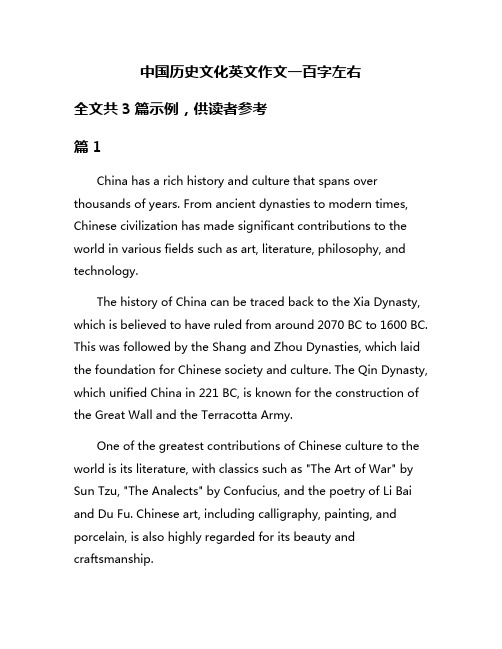
中国历史文化英文作文一百字左右全文共3篇示例,供读者参考篇1China has a rich history and culture that spans over thousands of years. From ancient dynasties to modern times, Chinese civilization has made significant contributions to the world in various fields such as art, literature, philosophy, and technology.The history of China can be traced back to the Xia Dynasty, which is believed to have ruled from around 2070 BC to 1600 BC. This was followed by the Shang and Zhou Dynasties, which laid the foundation for Chinese society and culture. The Qin Dynasty, which unified China in 221 BC, is known for the construction of the Great Wall and the Terracotta Army.One of the greatest contributions of Chinese culture to the world is its literature, with classics such as "The Art of War" by Sun Tzu, "The Analects" by Confucius, and the poetry of Li Bai and Du Fu. Chinese art, including calligraphy, painting, and porcelain, is also highly regarded for its beauty and craftsmanship.Chinese philosophy, particularly Confucianism and Taoism, has had a profound impact on Chinese society and ethics. Confucianism emphasizes moral values, respect for elders, and social harmony, while Taoism focuses on living in harmony with nature and the principles of yin and yang.In terms of technology, China is known for inventing paper, printing, gunpowder, and the compass, among other innovations. These inventions revolutionized communication, warfare, and navigation, and had a lasting impact on global history.Overall, China's history and culture have shaped the country into a rich tapestry of traditions, beliefs, and achievements that continue to influence the world today. By understanding and appreciating China's heritage, we can gain a deeper understanding of the complexities and beauty of this ancient civilization.篇2China has a long and rich history dating back thousands of years. With a history that spans over 5,000 years, China has a diverse and complex culture that has greatly influenced the world.One of the most important aspects of Chinese history and culture is the emphasis on tradition and respect for the past. Chinese civilization has been influenced by the teachings of Confucius, who emphasized the importance of filial piety, respect for elders, and adherence to tradition. These values have shaped Chinese society and culture for centuries, and are still important today.Another key aspect of Chinese history and culture is the development of the Chinese writing system. The Chinese writing system is one of the oldest in the world and has had a profound impact on the development of Chinese culture. Chinese calligraphy, which is the art of writing Chinese characters, is highly revered in Chinese culture and is considered a true form of artistic expression.Chinese history is also marked by periods of great innovation and achievement. The Han Dynasty, for example, is often considered a golden age of Chinese civilization, known for its advancements in technology, art, and literature. The Tang Dynasty is another example of a period of great cultural achievement, with advancements in poetry, music, and painting.Overall, Chinese history and culture are incredibly rich and diverse, with a long tradition of innovation and achievement.From the teachings of Confucius to the development of the Chinese writing system, China has made important contributions to the world and continues to influence global culture today.篇3Chinese history and culture can be traced back thousands of years, dating back to the earliest known dynasty, the Xia Dynasty, which ruled over China from around 2070 BCE to 1600 BCE. Over the centuries, China has seen the rise and fall of many dynasties, each leaving its mark on the country's rich cultural heritage.One of the most famous dynasties in Chinese history is the Han Dynasty, which ruled from 206 BCE to 220 CE and is often referred to as the "Golden Age" of China. During this time, China experienced significant advancements in science, art, and technology, and the Silk Road was established, allowing for trade and cultural exchange with other civilizations.Another important period in Chinese history is the Tang Dynasty, which ruled from 618 to 907 CE. The Tang Dynasty is often considered the peak of Chinese civilization, with great achievements in poetry, painting, and music. The capital city of Chang'an was one of the largest and most cosmopolitan cities in the world at that time.In addition to its rich history, China also boasts a diverse and vibrant culture, with influences from various ethnic groups and regions. Chinese cuisine is world-renowned for its flavors and ingredients, and traditional Chinese medicine has been practiced for thousands of years.Furthermore, Chinese art and literature have a long and storied history, with famous works such as the poetry of Li Bai and Du Fu, and the paintings of artists like Zhang Daqian and Xu Beihong.In conclusion, China's history and culture are both ancient and diverse, with a rich tapestry of traditions, customs, and beliefs that continue to influence the country and its people to this day.。
中国美食英文版
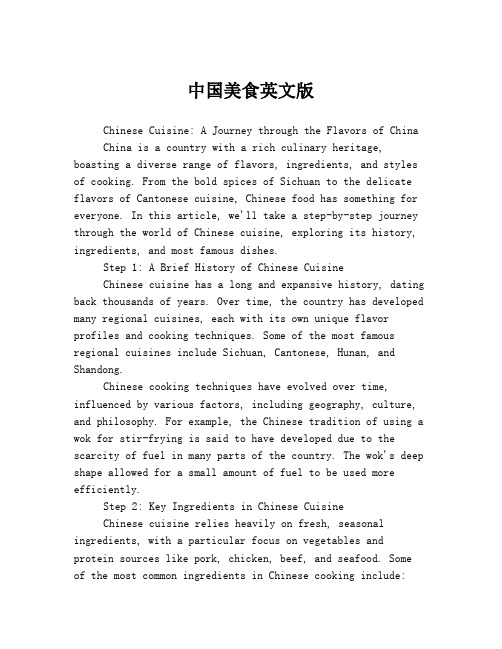
中国美食英文版Chinese Cuisine: A Journey through the Flavors of China China is a country with a rich culinary heritage, boasting a diverse range of flavors, ingredients, and styles of cooking. From the bold spices of Sichuan to the delicate flavors of Cantonese cuisine, Chinese food has something for everyone. In this article, we'll take a step-by-step journey through the world of Chinese cuisine, exploring its history, ingredients, and most famous dishes.Step 1: A Brief History of Chinese CuisineChinese cuisine has a long and expansive history, dating back thousands of years. Over time, the country has developed many regional cuisines, each with its own unique flavor profiles and cooking techniques. Some of the most famous regional cuisines include Sichuan, Cantonese, Hunan, and Shandong.Chinese cooking techniques have evolved over time, influenced by various factors, including geography, culture, and philosophy. For example, the Chinese tradition of using a wok for stir-frying is said to have developed due to the scarcity of fuel in many parts of the country. The wok's deep shape allowed for a small amount of fuel to be used more efficiently.Step 2: Key Ingredients in Chinese CuisineChinese cuisine relies heavily on fresh, seasonal ingredients, with a particular focus on vegetables andprotein sources like pork, chicken, beef, and seafood. Someof the most common ingredients in Chinese cooking include:- Rice: A staple food in China, rice is typically served with just about every meal. Different regions have their variations of rice, including glutinous rice, steamed rice, and fried rice.- Soy Sauce: This salty, umami-rich sauce is a staple in Chinese cuisine, used to season everything from stir-fries to marinades.- Sesame Oil: This nutty, flavorful oil is a commoningredient in Chinese cooking, used to add depth and richness to dishes.- Ginger and Garlic: These aromatic ingredients are widely used in Chinese cooking, adding heat and depth of flavor to dishes.- Spices: Chinese cuisine is known for its bold use of spices, including star anise, Sichuan peppercorns, and cinnamon.Step 3: Famous Chinese DishesThere are many famous Chinese dishes that have won over the taste buds of people around the world. Here are just afew to whet your appetite:- Kung Pao Chicken: A Sichuan classic, this spicy stir-fry dish features diced chicken, peanuts, and chili peppersin a soy sauce-based marinade.- Mapo Tofu: A dish from the Sichuan province, Mapo Tofu features soft tofu in a spicy sauce made with ground pork,chili paste, and Sichuan peppercorns.- Peking Duck: A famous dish from Beijing, Peking duck is a roasted duck served with thin pancakes and various condiments, including scallions and hoisin sauce.- Dim Sum: A Cantonese tradition, Dim Sum refers to a variety of small, bite-sized dishes, often served in steamer baskets. Popular dim sum dishes include shrimp dumplings, pork buns,and rice noodle rolls.- Hot Pot: A communal meal cooked at the table, hot pot involves dipping various raw ingredients, such as thinly sliced beef, vegetables, and tofu, into a simmering broth.In conclusion, Chinese cuisine is a fascinating and diverse world of flavors, ingredients, and techniques. From the fiery spices of Sichuan to the delicate flavors of Cantonese cuisine, there's never a dull moment in this culinary adventure. Whether you're a seasoned connoisseur or a curious beginner, Chinese cuisine is a must-try for anyone who loves good food.。
中国文化英语素材
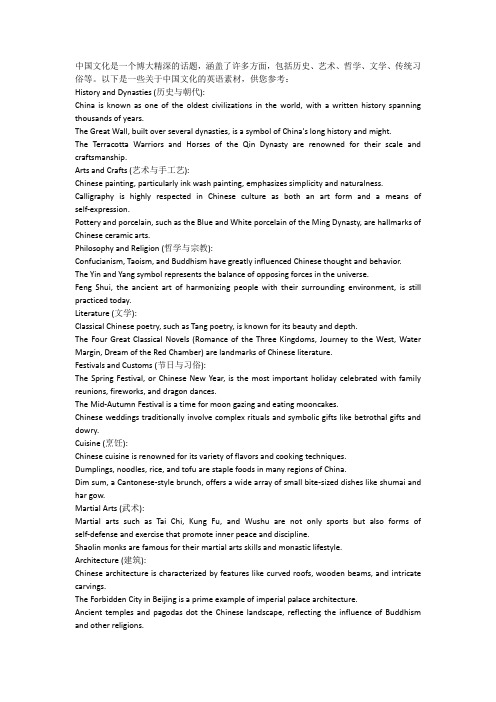
中国文化是一个博大精深的话题,涵盖了许多方面,包括历史、艺术、哲学、文学、传统习俗等。
以下是一些关于中国文化的英语素材,供您参考:History and Dynasties (历史与朝代):China is known as one of the oldest civilizations in the world, with a written history spanning thousands of years.The Great Wall, built over several dynasties, is a symbol of China's long history and might.The Terracotta Warriors and Horses of the Qin Dynasty are renowned for their scale and craftsmanship.Arts and Crafts (艺术与手工艺):Chinese painting, particularly ink wash painting, emphasizes simplicity and naturalness. Calligraphy is highly respected in Chinese culture as both an art form and a means of self-expression.Pottery and porcelain, such as the Blue and White porcelain of the Ming Dynasty, are hallmarks of Chinese ceramic arts.Philosophy and Religion (哲学与宗教):Confucianism, Taoism, and Buddhism have greatly influenced Chinese thought and behavior. The Yin and Yang symbol represents the balance of opposing forces in the universe.Feng Shui, the ancient art of harmonizing people with their surrounding environment, is still practiced today.Literature (文学):Classical Chinese poetry, such as Tang poetry, is known for its beauty and depth.The Four Great Classical Novels (Romance of the Three Kingdoms, Journey to the West, Water Margin, Dream of the Red Chamber) are landmarks of Chinese literature.Festivals and Customs (节日与习俗):The Spring Festival, or Chinese New Year, is the most important holiday celebrated with family reunions, fireworks, and dragon dances.The Mid-Autumn Festival is a time for moon gazing and eating mooncakes.Chinese weddings traditionally involve complex rituals and symbolic gifts like betrothal gifts and dowry.Cuisine (烹饪):Chinese cuisine is renowned for its variety of flavors and cooking techniques.Dumplings, noodles, rice, and tofu are staple foods in many regions of China.Dim sum, a Cantonese-style brunch, offers a wide array of small bite-sized dishes like shumai and har gow.Martial Arts (武术):Martial arts such as Tai Chi, Kung Fu, and Wushu are not only sports but also forms of self-defense and exercise that promote inner peace and discipline.Shaolin monks are famous for their martial arts skills and monastic lifestyle.Architecture (建筑):Chinese architecture is characterized by features like curved roofs, wooden beams, and intricate carvings.The Forbidden City in Beijing is a prime example of imperial palace architecture.Ancient temples and pagodas dot the Chinese landscape, reflecting the influence of Buddhism and other religions.Music (音乐):The erhu, pipa, guzheng, and xun are traditional Chinese musical instruments.Peking Opera combines music, singing, dance, acrobatics, and mime to tell stories from Chinese history and mythology.Traditional Medicine (传统医学):Traditional Chinese Medicine (TCM) includes practices like acupuncture, herbal remedies, and qigong exercises for maintaining health.The concept of qi (life force) and yin-yang balance is central to TCM philosophy.。
中国的历史文化英文作文
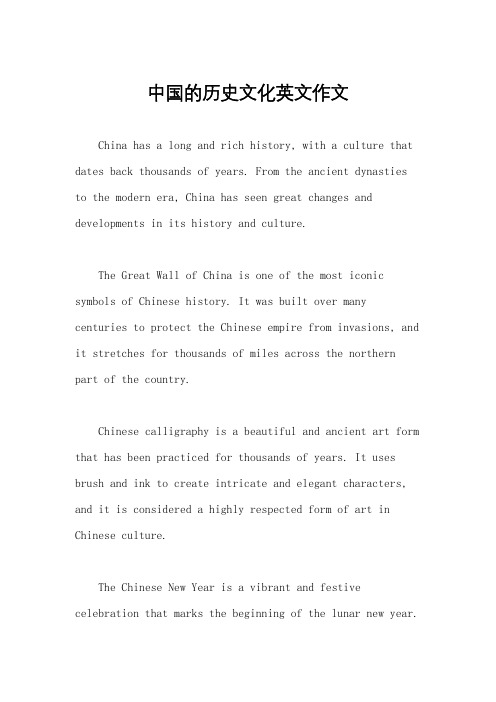
中国的历史文化英文作文China has a long and rich history, with a culture that dates back thousands of years. From the ancient dynasties to the modern era, China has seen great changes and developments in its history and culture.The Great Wall of China is one of the most iconic symbols of Chinese history. It was built over many centuries to protect the Chinese empire from invasions, and it stretches for thousands of miles across the northern part of the country.Chinese calligraphy is a beautiful and ancient art form that has been practiced for thousands of years. It uses brush and ink to create intricate and elegant characters, and it is considered a highly respected form of art in Chinese culture.The Chinese New Year is a vibrant and festive celebration that marks the beginning of the lunar new year.It is a time for family reunions, feasting, and colorful parades and performances.Confucianism, Taoism, and Buddhism are three of themost influential philosophies and religions in Chinese culture. They have shaped the moral and spiritual beliefsof the Chinese people for centuries.Traditional Chinese medicine, including acupuncture and herbal remedies, has been practiced for thousands of years and is still widely used in China and around the world.The Forbidden City in Beijing is a magnificent palace complex that was once the home of Chinese emperors. It is a UNESCO World Heritage site and a popular tourist attraction.The Terracotta Army, discovered in the tomb of thefirst Emperor of China, is a collection of thousands oflife-sized clay soldiers and horses that were buried withthe emperor to protect him in the afterlife.Chinese cuisine is incredibly diverse and delicious,with a wide variety of flavors, ingredients, and cooking styles. It is considered one of the world's great culinary traditions.The ancient art of Chinese tea ceremony is a ritualized way of preparing and serving tea that has been practicedfor centuries. It is a peaceful and meditative practicethat reflects the harmony and balance of Chinese culture.The modern era has seen rapid development and change in China, with a booming economy, technological advancements, and a growing global influence. China continues to be a fascinating and dynamic country with a rich history and culture.。
中国饮食文化 英文版

Eight Culinary Traditions of China 八大菜系
Chinese dishes may be categorized as one of the Eight Culinary Traditions of China, also called the "Eight Regional Cuisines" and the "Eight Cuisines of China".
李鸿章杂烩
相传公元1896年,李鸿章奉旨到俄国参加皇 尼古拉二世 的加冕典礼,顺道访问欧美。一路上吃了两个多月的西餐, 胃口都吃倒了,所以一到美国就叫使馆的厨师用中国徽宴 请美国宾客。曾宴请美国宾客,因中国菜可口美味,深受 欢迎,连吃几个小时洋人还不肯下席。此时总管向他禀告: “中堂大人,菜已吃完,怎么办?”李鸿章略加思索后说: “把撤下去的残菜混在一起加热,用大盆端上来”。不一 会儿,热气腾腾的菜端上桌,洋人尝后连声叫好,便问菜 名,李鸿章一时答不上来,只是说:“好吃多吃!”岂料 歪打正着,“好吃多吃”与英语杂烩(Hotchpotch)发音 相近,后来此菜便被命名为“李鸿章杂烩”。” 另一种说法是:李命厨师加菜,但正菜已上完,厨师 只好将所剩海鲜等余料混合下锅,烧好上桌,外宾尝后赞 不绝口,并询问菜名,李用合肥话说:“杂碎”(即杂烩 谐音)。此后,“大杂烩”便在美国传开,合肥城乡也仿 而效之,遂成名菜。
Eight Culinary Traditions of China 八大菜系
Hui Cantonese Min Hunan Su Lu chuan Zhe
徽菜 粤菜 闽菜 湘菜 苏菜 鲁菜 川菜 浙菜
Ridiculous translation
中国文化概况英汉对照版
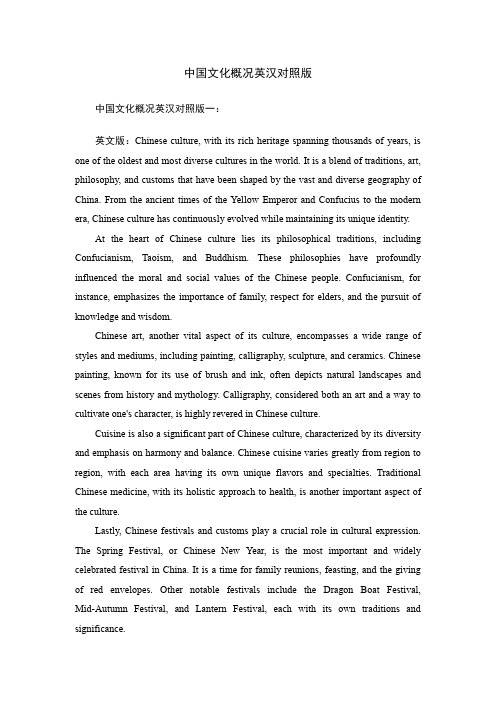
中国文化概况英汉对照版中国文化概况英汉对照版一:英文版:Chinese culture, with its rich heritage spanning thousands of years, is one of the oldest and most diverse cultures in the world. It is a blend of traditions, art, philosophy, and customs that have been shaped by the vast and diverse geography of China. From the ancient times of the Yellow Emperor and Confucius to the modern era, Chinese culture has continuously evolved while maintaining its unique identity.At the heart of Chinese culture lies its philosophical traditions, including Confucianism, Taoism, and Buddhism. These philosophies have profoundly influenced the moral and social values of the Chinese people. Confucianism, for instance, emphasizes the importance of family, respect for elders, and the pursuit of knowledge and wisdom.Chinese art, another vital aspect of its culture, encompasses a wide range of styles and mediums, including painting, calligraphy, sculpture, and ceramics. Chinese painting, known for its use of brush and ink, often depicts natural landscapes and scenes from history and mythology. Calligraphy, considered both an art and a way to cultivate one's character, is highly revered in Chinese culture.Cuisine is also a significant part of Chinese culture, characterized by its diversity and emphasis on harmony and balance. Chinese cuisine varies greatly from region to region, with each area having its own unique flavors and specialties. Traditional Chinese medicine, with its holistic approach to health, is another important aspect of the culture.Lastly, Chinese festivals and customs play a crucial role in cultural expression. The Spring Festival, or Chinese New Year, is the most important and widely celebrated festival in China. It is a time for family reunions, feasting, and the giving of red envelopes. Other notable festivals include the Dragon Boat Festival, Mid-Autumn Festival, and Lantern Festival, each with its own traditions and significance.汉语对照版:中国文化,拥有数千年的丰富遗产,是世界上最古老、最多样化的文化之一。
中国历史文化概况(英文版)Unit-10-Chinese-Cuisine--Tea-and-Medi

• Located along the southern coast of China, Guangdong abounds with food of animal and plant sources. At the same time, Guangzhou has been a long-standing treaty port city, which attracted and absorbed various foreign cooking materials and techniques. And thus Yue Cuisine was gradually perfected. In addition, overseas Chinese brought the cooking techniques from Europe, America and Southeast Asia back to their hometown and accordingly enriched the recipes of Yue Cuisine. There are very obvious traces of Western cooking techniques in Yue Cuisine.
Sichuan Cuisine
中国文化概况中英版

中国文化概况中英版An Overview of Chinese Culture (English Version)I. IntroductionChinese culture, with its long history and profound essence, is the sum of material and spiritual cultures created and passed down by the Chinese nation throughout its historical development. Chinese culture emphasizes humanism, focusing on moral values, etiquette, family, and social order.II. Main Contents1. History and EvolutionChinese culture boasts a rich history spanning thousands of years, from the Xia, Shang, and Zhou dynasties to the Spring and Autumn period, the Warring States period, and then to the Tang, Song, Yuan, Ming, and Qing dynasties. It has continuously absorbed and integrated foreign cultures, forming a unique cultural system.2. Traditional ValuesConfucianism is one of the cornerstones of Chinese culture, emphasizing virtues such as benevolence, filial piety, loyalty, and etiquette, which have profoundly influenced the behavior and values of the Chinese people. Taoism emphasizes the harmony between man and nature, advocating a natural and non-interventionist approach. Buddhism, on the other hand, emphasizes compassion and self-sacrifice, having a significant impact on Chinese religion and philosophy.3. Cultural Characteristics- Festival Culture: China has many traditional festivals, such as the Spring Festival, Mid-Autumn Festival, and Dragon Boat Festival, each with unique celebration methods and cultural connotations.- Clothing Culture: Traditional Chinese clothing, such as Hanfu and Tangzhuang, reflects the unique aesthetic concepts and cultural characteristics of the Chinese nation.- Architectural Culture: Traditional Chinese architecture, including palaces, temples, and gardens, is renowned for its distinctive styles and exquisite craftsmanship.- Cuisine Culture: Chinese cuisine, known for its rich flavors and exquisiteculinary techniques, is an important representation of China's cultural charm.4. Influence on the WorldThe values and ideological systems of Chinese culture have had a profound impact on the world, especially Confucianism, which has influenced Asia and beyond. Traditional Chinese arts and forms of expression, such as calligraphy, painting, and Peking Opera, are also deeply loved and admired by people around the world.III. ConclusionChinese culture is a treasure of the Chinese nation, embodying unique charm and value. Through learning and understanding Chinese culture, we can gain a deeper understanding of the history, traditions, and spiritual outlook of the Chinese people, further enhancing our sense of national pride and self-confidence. At the same time, Chinese culture has also made significant contributions to the diversity and development of world culture.中国文化概况中英版一、引言中国文化,源远流长,博大精深,是中华民族在长期历史发展过程中所创造并传承下来的物质文化和精神文化的总和。
介绍中国传统文化的英语作文

介绍中国传统文化的英语作文China, with a history spanning over five millennia, boasts a cultural heritage that is both profound and diverse. This essay aims to delve into the various aspects of Chinese traditional culture, highlighting its unique customs, art forms, and philosophical underpinnings that have shaped the nation's identity.Philosophical FoundationsAt the heart of Chinese traditional culture lies a set of philosophical teachings that have guided the moral andethical framework of the society. Confucianism, with its emphasis on social harmony, familial piety, and theimportance of education, has been particularly influential. Laozi's Taoism, which advocates for a life of simplicity and harmony with nature, complements Confucian thought, offeringa different perspective on living in balance with the world.Festivals and CelebrationsChinese festivals are a vibrant display of the country's cultural heritage. The most significant is the Spring Festival, also known as Chinese New Year, which marks the beginning of the lunar calendar. Families gather for reunions, feasting on traditional foods like dumplings and rice cakes, and engaging in customs such as setting off fireworks to ward off evil spirits. Other notable festivals include the Mid-Autumn Festival, where mooncakes are shared in honor of the full moon, and the Dragon Boat Festival, which features races of the eponymous boats and the eating of zongzi, a type of rice dumpling.Traditional ArtsThe arts in China have a long and storied history, with calligraphy and painting being two of the most revered forms. Chinese calligraphy is an art form that not only involves the aesthetic writing of characters but also reflects the inner spirit and character of the calligrapher. Traditional Chinese painting, often characterized by its use of brush and ink on silk or paper, captures the essence of nature and landscapes with a focus on balance and harmony.Music and OperaChinese music is distinct for its use of traditional instruments such as the guqin, a seven-stringed zither, and the pipa, a four-stringed lute. These instruments are often used in classical music that dates back centuries. Chinese opera is another treasure, with Peking opera being the most famous. It combines music, vocal performance, mime, dance, and acrobatics to tell stories that often draw from history or mythology.Architecture and DesignChinese architecture is renowned for its emphasis on symmetry and the integration of natural and man-made elements. TheForbidden City in Beijing and the Temple of Heaven are prime examples of this architectural philosophy. The design principles often revolve around the concept of feng shui, which seeks to harmonize the flow of energy within a space.CuisineChinese cuisine is as diverse as its culture, with each region offering its own unique dishes and cooking styles. From the spicy Sichuan cuisine to the sweet and sour flavors of Cantonese cooking, the culinary landscape is vast. Ingredients are chosen for their medicinal properties as well as their taste, reflecting the holistic approach to life that is characteristic of Chinese culture.ConclusionChinese traditional culture is a mosaic of various elements that have been honed over thousands of years. It is a culture that values harmony, balance, and respect for nature and ancestors. As China continues to modernize, these traditional aspects of its culture remain a source of pride and continuity, offering a rich tapestry of history and tradition for the world to appreciate and learn from.。
中国饮食文化——英文版

中国饮食文化——英文版Chinese CuisineChina is known for its rich and diverse culinary traditions, which reflect the country's long history and regional variations. Chinese cuisine is celebrated for its wide range of flavors, use of fresh ingredients, and emphasis on balance and harmony. From hearty rice and noodle dishes to delicate dumplings and richstir-fried dishes, Chinese food offers something for everyone.Another defining characteristic of Chinese cuisine is theuse of fresh and seasonal ingredients. Chinese chefs believethat fresh ingredients not only enhance the taste, but also the nutritional value of the dish. Fresh vegetables, herbs, and spices are used extensively in Chinese cooking to add flavor and color to the dishes. Popular ingredients include ginger, garlic, soy sauce, and sesame oil.Chinese cuisine is also known for its wide variety ofcooking techniques. From stir-frying and deep-frying to boiling and steaming, Chinese chefs have mastered a range of techniquesto bring out the best flavors in their dishes. Each technique requires a different level of heat and timing, ensuring that the food is cooked to perfection.Regional variations play a significant role in Chinese cuisine, with each region having its own distinct culinarytraditions. For example, Cantonese cuisine is known for its delicate flavors and emphasis on fresh ingredients. Sichuan cuisine, on the other hand, is famous for its bold and spicy flavors. Other regional cuisines include Shandong, Hunan, and Fujian, each with their own unique styles and flavors.In conclusion, Chinese cuisine is a reflection of the country's deep-rooted history and regional diversity. With its emphasis on balance, fresh ingredients, and a variety of cooking techniques, Chinese food has earned its rightful place among the world's most celebrated culinary traditions. Whether you're enjoying a steaming bowl of noodles or savoring the flavors of a traditional dim sum feast, Chinese cuisine offers a unique and unforgettable dining experience.。
介绍中国美食的历史特色英语作文
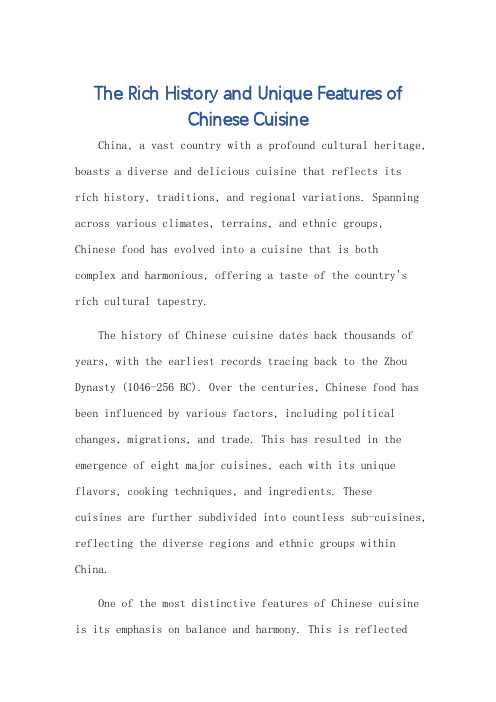
The Rich History and Unique Features ofChinese CuisineChina, a vast country with a profound cultural heritage, boasts a diverse and delicious cuisine that reflects itsrich history, traditions, and regional variations. Spanning across various climates, terrains, and ethnic groups, Chinese food has evolved into a cuisine that is both complex and harmonious, offering a taste of the country's rich cultural tapestry.The history of Chinese cuisine dates back thousands of years, with the earliest records tracing back to the Zhou Dynasty (1046-256 BC). Over the centuries, Chinese food has been influenced by various factors, including political changes, migrations, and trade. This has resulted in the emergence of eight major cuisines, each with its unique flavors, cooking techniques, and ingredients. Thesecuisines are further subdivided into countless sub-cuisines, reflecting the diverse regions and ethnic groups within China.One of the most distinctive features of Chinese cuisine is its emphasis on balance and harmony. This is reflectedin the use of the five elements - wood, fire, earth, metal, and water - in cooking, as well as the principles of Yin and Yang. The aim is to create dishes that are not only delicious but also beneficial for health and well-being.Another notable feature of Chinese cuisine is its use of seasonings and condiments. Chinese chefs are masters of flavor combinations, using a wide range of spices, sauces, and condiments to enhance the taste of their dishes. Common seasonings include soy sauce, vinegar, ginger, garlic, and chili peppers, which are used to create complex and layers of flavors.The preparation of Chinese food also involves meticulous attention to detail. From the selection of ingredients to the cooking techniques employed, every step is carefully considered to ensure that the final dish is a masterpiece of taste and presentation. Chinese chefs are experts at using various cooking methods such as steaming, boiling, frying, and baking to bring out the best flavorsin their ingredients.Moreover, Chinese cuisine is renowned for its use of fresh produce and seafood. With a vast array of fruits,vegetables, and seafood available, Chinese chefs are able to create dishes that are both nutritious and delicious. The use of local ingredients is also emphasized, reflecting the close connection between Chinese food and the land it grows from.In conclusion, the history and features of Chinese cuisine are as rich and diverse as the country itself. Its emphasis on balance, harmony, and flavor combinations, along with its use of fresh ingredients and meticulous cooking techniques, have made Chinese food a favorite among food lovers worldwide. From the elaborate banquets of the imperial court to the simple yet delicious street food, Chinese cuisine offers a culinary journey that is both exciting and satisfying.**中国美食的丰富历史与独特特色**中国,一个幅员辽阔、文化深厚的国家,其美食反映了其丰富的历史、传统和地区差异。
介绍一个中国历史文化名城英语作文

介绍一个中国历史文化名城英语作文China is a country with a long history and rich cultural heritage. One of the most famous historical and cultural cities in China is Xi'an, which is located in the central part of the country in Shaanxi Province.Xi'an is known for its ancient city walls, which date back to the Ming Dynasty and are still well-preserved today. The city is also home to the famous Terracotta Army, a collection of thousands of life-sized terracotta sculptures depicting the armies of Qin Shi Huang, the first Emperor of China.In addition to its historical sites, Xi'an is also known for its delicious cuisine, including the famous Xi'an noodles and roujiamo, a type of Chinese hamburger. Thecity's Muslim Quarter is a popular destination for food lovers, with its bustling markets and street food stalls.Xi'an's history dates back over 3,000 years, and it has been the capital of several ancient Chinese dynasties. The city has played a significant role in Chinese history andculture, and its historical sites continue to attract tourists from around the world.中国是一个历史悠久、文化底蕴丰厚的国家。
- 1、下载文档前请自行甄别文档内容的完整性,平台不提供额外的编辑、内容补充、找答案等附加服务。
- 2、"仅部分预览"的文档,不可在线预览部分如存在完整性等问题,可反馈申请退款(可完整预览的文档不适用该条件!)。
- 3、如文档侵犯您的权益,请联系客服反馈,我们会尽快为您处理(人工客服工作时间:9:00-18:30)。
Chinese Cuisine, Tea and Medicine
Lu Cusine
• Lu Cuisine refers to Shangdong dishes, featuring dense taste and favor of shallot and garlic, especially apt at the cooking of seafood, soup and a variety of bowels. Famous flavored dishes include Dezhou braised boneless chicken, braised intestines in brown sauce, and braised Yellow River carp with sweet and sour taste.
Benbang Cuisine
• Shanghai cuisine is the youngest among the ten major cuisines in China though with a history of more than 400 years. Traditionally called Benbang cuisine, it originated in the Ming and Qing Dynasties (1368-1840). Shanghai dishes usually look red and shiny, for they are often pickled in wine and their cooking methods include baking, stewing, teaming, deep-frying, etc. In the later part of 19th century after Shanghai became a major domestic and international trading port,Benbangdishes underwent some substantial changes by adopting certain merits of other cuisines. It formed a complex flavor structure, cooking style and technique norms. It stresses on using condiments and keeping the original flavors of the materials and has features of being fresh, smooth and crispy. Shanghai Dishes aim at lightness in flavor, and beautifulness in decoration.
Sichuan Cuisine
• Sichuan cuisine enjoys a time-honored history and is well-reputed home and abroad. Represented by the local dishes of Chengdu and Chongqing, Sichuan cuisine is particular about ingredients, unified in standard, distinctive in arrangement, and vivid in coordination. Sichuan cuisine features spicy, tongue-numbing, savory, delicious, oily and heavily seasoned flavor, using a lot of capsicum, prickly ash, pepper as well as fresh ginger. From high-class banquet to ordinary meal, from street snack to home-made dishes, Sichuan cuisines is diversified in variety, novel in style, and elaborate in cooking.
Cantonese Cuisine
• Yue Cuisine, namely Guangdong flavor dishes, is one of the four Chinese cuisines. It enjoys extremely good reputation at home and abroad for its unique types of dishes and special charm.
Min Cuisine
• Min Cuisine, one of the Eight Cuisines of China, is mainly represented by dishes of Fuzhou and Xiamen styles. The dishes of Xiamen style are of strong local flavor of southern Fujian, which feature light soup and flavor, crisp stir-fried dish, and excellent seafood cooking techniques.
• Located along the southern coast of China, Guangdong abounds with food of animal and plant sources. At the same time, Guangzhou has been a long-standing treaty port city, which attracted and absorbed various foreign cooking materials and techniques. And thus Yue Cuisine was gradually perfected. In addition, overseas Chinese brought the cooking techniques from Europe, America and Southeast Asia back to their hometown and accordingly enriched the recipes of Yue Cuisine. There are very obvious traces of Western cooking techniques in Yue Cuisine.
